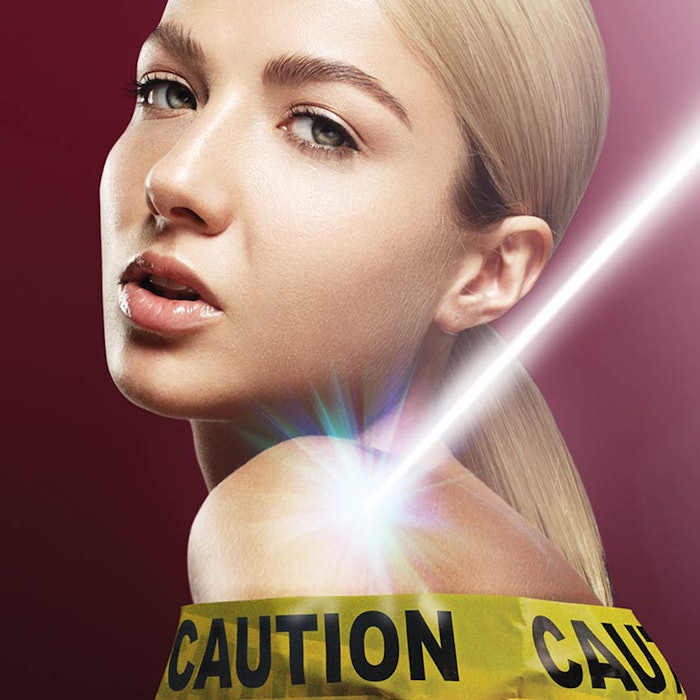
Laser and light therapy treatments are one of the most popular treatments available in the esthetic industry. As new technology is continually developed and consumer awareness grows, skin care providers want the opportunity to offer these treatments to clients.
Those that have observed or received treatments may think working with lasers is a simple task. This is somewhat due to recent advancements in the industry that make devices user-friendly. Regardless of the ease of use, an understanding of safety regulations, laser and light physics and tissue interaction is necessary to perform safe, effective treatments.
Background Knowlege
Professionals working with lasers, whether they are assisting, preparing or performing the treatments, must know laser physics and tissue interaction.
LASER is actually an acronym for Light Amplification by Stimulated Emission of Radiation. These terms are broken down and explained below.
Light. Visible or invisible dependent upon wavelength
Amplification. Increased energy
Stimulated. To excite
Emission. Molecular process in which energy is released
Radiation. Energy moved from one place to another
The focus of laser training for many practitioners tends to be the hands-on portion. When operating a laser, it is necessary to get the proper hands-on training with the device that is being utilized. However, it is pointless to learn how to physically deliver the light energy without a thorough understanding how the light is interacting with the tissue. The type of laser or light therapy being used, the amount of energy delivered, the duration, and most importantly why it should be delivered should all be known before any type of light is applied to the skin. Similar to chemical peels, should someone that does not know the type of acid, the percentage or the pH be able to apply a chemical peel by only learning application technique? Unfortunately, there are laser technicians that do not know what a laser is, and some have been practicing for many years. It is no wonder that regulatory agencies are enforcing more strict rules on who can perform laser and light-based treatments.
Several laser and light therapy devices now have special features to simplify choosing treatment settings. Some protocols are as simple as entering a client’s Fitzpatrick type and the indicated target, including its size and/or density. Newer devices can even read the treatment area and select settings accordingly, similar to leaving the provider on auto-pilot. While this technology is great to have available, too many rely on the equipment so much that they do not consider if settings need to be adjusted.
Those working with lasers should be comfortable with knowledge received and follow safety protocols.
Safety Protocols
There are several safety guidelines that must be followed according to federal and state regulations. These are just a few of the significant safety guidelines that should be administered.
Standard Operating Procedures (SOPS). SOPs must be created and used for each treatment performed in a medical setting. SOPs are a recognized component to proper practice management and office efficiency. They serve to educate and assure that providers follow good clinical practices. At one time, they may be required by local, regional and/or state regulatory bodies and subjected to evaluation. Although many of the standard practice procedures are somewhat consistent across the country, SOPs are best when customized to each practice.
Laser Treatment Control Area (LTCA). Lasers are highly reactive devices; therefore, the treatment room must comply with all Occupational Safety and Health Administration (OSHA) regulation. For example, a fire extinguisher with a current safety status must be kept in each treatment room, and all staff members should be trained on how it is operated. Following are some safety procedures required of a LTCA.
- Windows must be covered with the appropriate flame retardant material.
- Avoid hanging mirrors or other reflective surfaces in the laser treatment room, as this may cause the beam to reflect and cause a specular or diffuse reaction.
- A warning sign when the laser is in use must be placed on the outer side of the treatment room door that states, “Danger: visible and/or invisible laser radiation, avoid eye or skin exposure to direct or scattered radiation.”
- During treatments, the door to the laser room should be closed but never locked.
- The key must be taken out of the device between treatments and locked away when not in use to prevent future liabilities.
Eye protection. The eye is most vulnerable to damage when working with lasers. The damage lasers can cause to the eyes is irreversible and certainly never worth the risk. Any person in the controlled laser treatment area must use eye protection designated for that particular device at all times.
The type of eye protection varies per device; regulations state that all goggles must be clearly labeled with wavelength and optical density (OD) to ensure safety. Goggles must also have side shields to protect from light entering the eye area peripherally. If banded goggles are used on the patient, they must fit securely. Always check eyewear for signs of damage.
Treatment Protocols
Intake form. A medical intake form must be filled out by the patient and reviewed by the appropriate medical professional. A pre-laser checklist should be completed prior to each treatment. Common inquiries include pregnancy, change in medical conditions or medication, medical history, recent procedures in the area, level of sun exposure or use of self-tanners.
Consult. Make sure clients are aware of all possible post-treatment reactions and any side effects that would require immediate attention. Remember, anything you tell a client before a treatment is seen as an explanation; anything you tell them after is seen as an excuse.
Cleanse. All treatment areas must be properly cleansed following a thorough skin assessment. Beware of moisturizers, perfumes and other topical products, as they could contain flammable substances.
Test. It is without question that busy practices and clients would like to shorten treatment times; however, patch tests are always necessary with lasers since there can be a delayed response in skin reaction. Patch tests should be performed according to manufacturer and practice standards.
Be cautious. During the patch test, as well as during the treatment, watch for signs of excess erythema, swelling, or burns on the treatment area. If anything looks suspicious, the treatment should be discontinued.
Regulation
There are strict regulations on who can perform laser and light based treatments, which differ by state. These should be reviewed before any laser or light procedure is conducted. Some state regulations allow estheticians to perform light therapy treatments, while others only allow medical professionals. Some regulatory agencies will allow a designated employee with proper training to perform the treatment as long as the physician has performed the initial consultation. This is true of several esthetic devices used today and will be addressed by myself and other industry experts during the opening panel at Face & Body Northern California on Aug. 22, 2015.
It is the responsibility of the laser owner, the certified laser safety officer and each spa member to maintain all standards set forth by the regulating agencies whose oversight governs the state and/or county in which laser services are being performed. Regulatory agencies include: The American National Standards Institute (ANSI), The Center for Devices and Radiological Health (CDRH), the Food and Drug Administration (FDA), OSHA and the American Society for Laser Medicine and Surgery (ASLMS).
Laser Treatment Gone Wrong
I have been working with lasers for about 12 years and training esthetic professionals for 10 of those. When I first started training on lasers, my educator (representative) taught me to follow a chart and choose settings accordingly. As I am always into learning as much as I can, I asked many questions as to why. “Why do we choose this amount of joules? What are joules? What does pulse width mean?” I was told that I was looking too much into it and all I needed to do was follow the chart that was given to me. So I did as I was told and brought in family members for practice.
I treated my sister’s entire body for laser hair removal, staying within the range provided on the chart. I finally reached the back of her thighs, when she started crying out that it was burning. I responded, “Well it looks fine, and I am at the right setting so just bear with me. We are almost done.” She called that night in extreme pain. She had third-degree burns on the back of her thighs and had to sit in a bath tub full of ice to ease the discomfort. The physician I was working for at the time had to treat her with topical steroids. This happened right before summer and prevented my sister from being able to expose her thighs. She had black blocks up the surface of her thighs, which later turned to hypopigmented areas.
The reason this complication occurred is because I did not have the education needed to operate the laser. I am not blaming the trainer; I blame myself for knowing I was not properly educated on the tissue interaction and physics. The fact is, I had no idea why I was choosing these settings except for it said it on the chart according to her skin color and hair texture. I was also told that neither I nor the patient needed to wear safety goggles, as they were not easy to see out of. As long as we blinked during pulses, we were told our eyes would be fine.
Lasers are considered medical devices, and there are reported cases of blinding from improper protection during treatments. More common are burns, but not just small burns—severe burns that lead to a life of pigment changes and scars. Many do not think of the severe psychological implications this can cause as well. As accidents can occur, I was able to see the other side by being closely involved in the process. I received calls nightly from my sister crying that she would be scarred for life, and she was severely depressed. From my own experience, if something does not seem right or if proper education on a product or device is not given, do not use it until it is fully understood. Learn from my mistake, it is worth it to wait.
Be Safe
Lasers are powerful medical devices and should be treated as such. Proper education should be in place and taken seriously, including laser physics and tissue interactions. All technicians should be knowledgeable on all aspects of the skin and possible treatment reactions. This is a brief overview of some of the many factors that go into safe, effective treatments. Remember, if there is any hesitation regarding execution, it is worth the wait to ensure success.











